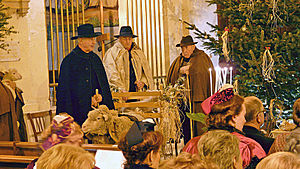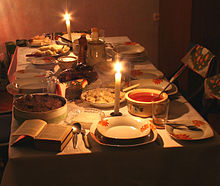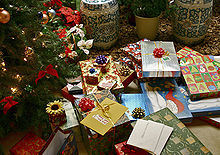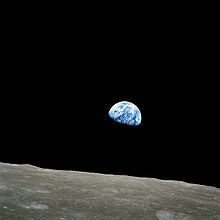- Christmas Eve
-
Christmas Eve is the day that, according to modern calendars, contains the evening, or first evening, of Christmas, a widely celebrated festival commemorating the birth of Jesus of Nazareth. It is a culturally significant celebration for most of the Western world and is widely observed as a full or partial holiday in anticipation of Christmas.
The reason why Christmas starts on Christmas Eve is that the traditional Christian liturgical day starts at sunset,[1] an inheritance from Jewish tradition[2] and based in the story of creation in Genesis: "And there was evening, and there was morning – the first day."[3] This liturgical day is followed for all days in the Eastern rite[4] and the custom of beginning Christmas celebration (as well as Sunday and the other major festivals) in the preceding evening is preserved in western Churches that have altered the liturgical day to start at midnight, for example the Roman Catholic Church.[5] Many churches still ring their church bells and hold prayers in the evening before holidays; for example the Nordic Lutheran churches.[6] In some languages, such as the Scandinavian, Christmas Eve is simply referred to as "Christmas Evening".
Since Christian tradition holds that Jesus was born at night (based in Luke 2:6-8) Midnight mass is celebrated on Christmas Eve, traditionally at midnight, in memory of his birth.[7] The idea of Jesus being born at night is reflected in the fact that Christmas Eve is referred to as "Heilige Nacht" ("Holy Night") in German, "Nochebuena" ("the Good Night") in Spanish and similarly in other expressions of Christmas spirituality, such as the song "Silent Night, Holy Night".
Non-religious people, or people who are not formal with definitions, may see the whole day as a day of celebration or as just the day before Christmas. Many people all over the world celebrate Christmas without being religious or even of a Christian background. The emphasis of celebration on Christmas Eve or Christmas Day varies from country to country and region to region (see below).
In Western culture, Christmas Eve is mostly celebrated on December 24. However, the Coptic, Serbian, Russian, Macedonian, Georgian, and Ukrainian Orthodox Churches,[disambiguation needed
 ] as well as the Greek Orthodox Church of Jerusalem, use the Julian calendar, which is currently 13 days behind the Gregorian calendar, so Christmas Eve for the adherents of those churches coincides with January 6 of the following year in the Gregorian calendar.
] as well as the Greek Orthodox Church of Jerusalem, use the Julian calendar, which is currently 13 days behind the Gregorian calendar, so Christmas Eve for the adherents of those churches coincides with January 6 of the following year in the Gregorian calendar.Contents
Religious traditions
Western Churches
Roman Catholics and Anglicans traditionally celebrate Midnight Mass, which begins either at or sometime before midnight on Christmas Eve. This ceremony, which is held in churches throughout the world, marks the beginning of Christmas Day.
In recent years some churches have scheduled their "Midnight" Mass as early as 7 pm In Spanish-speaking areas, the Midnight Mass is sometimes referred to as Misa del Gallo, or "Missa do Galo", in Portuguese ("Rooster's Mass"). In the Philippines, this custom lasts for nine days, starting on December 16 and continuing daily up to December 24, during which Filipinos attend dawn Masses, usually starting at around 4:00–5:00 am In 2009 Vatican officials scheduled the Midnight Mass to start at 10 pm so the 82 year old Pope Benedict XVI would not have too late a night.[8]
Whilst not performing any kind of Mass per se, the Church of Scotland has a Watchnight (similar to the one on Hogmanay) service beginning just before midnight, wherein carols are sung.
Lutherans traditionally practice Christmas Eve Eucharistic traditions typical of Germany and Scandinavia. "Krippenspiele" (Nativity plays), special festive music for organ, vocal and brass choirs and candlelight services make Christmas Eve one of the highlights in the Lutheran Church calendar. Christmas Vespers are popular in the early evening, and midnight services are also widespread in regions which are predominately Lutheran. The old Lutheran tradition of a Christmas Vigil in the early morning hours of Christmas Day (Christmette) can still be found in some regions. In eastern and middle Germany, congregations still continue the tradition of "Quempas singing": separate groups dispersed in various parts of the church sing verses of the song "He whom Shepherds once came Praising" (Quem pastores) responsively.
Methodists celebrate the evening in different ways. Some, in the early evening, come to their church to celebrate Holy Communion with their families. The mood is very solemn, and the only visible light is the Advent Wreath, and the candles upon the Lord's Table. Others celebrate the evening with services of light, which include singing the song "Silent Night" as a variety of candles (including personal candles) are lit. Other churches have late evening services at 11 pm, so the church can celebrate Christmas Day together with the ringing of bells at 12 am Others offer Christmas Day services, as well.
The annual "Nine Lessons and Carols" broadcast from King's College, Cambridge, on Christmas Eve, has established itself as one of the signs that Christmas has begun in the United Kingdom.[9] It is broadcast outside the UK via the BBC World Service, and is also bought by broadcasters around the world.[9]
Other churches hold a candlelight service. Some services re-enact the Nativity. Each church is able to celebrate Christmas Eve evening and Christmas Day in its own special way.
Eastern Churches
In the Eastern Orthodox Church, Christmas Eve is referred to as Paramony ("preparation"). It is the concluding day of the Nativity Fast and is celebrated as a day of strict fasting by those devout Orthodox Christians who are physically able to do so. In some traditions, nothing is eaten until the first star appears in the evening sky, in commemoration of the Star of Bethlehem. The liturgical celebration begins earlier in the day with the celebration of the Royal Hours, followed by the Divine Liturgy combined with the celebration of Vespers, during which a large number of readings from the Old Testament are chanted, recounting the history of salvation. After the dismissal at the end of the service, a new candle is brought out into the center of the church and lit, and all gather round and sing the Troparion and Kontakion of the Feast.
In the evening, the All-Night Vigil for the Feast of the Nativity is composed of Great Compline, Matins and the First Hour. The Orthodox services of Christmas Eve are intentionally parallel to those of Good Friday, illustrating the theological point that the purpose of the Incarnation was to make possible the Crucifixion and Resurrection. This is illustrated in Orthodox icons of the Nativity, on which the Christ Child is wrapped in swaddling clothes reminiscent of his burial wrappings. The child is also shown lying on a stone, representing the Tomb of Christ, rather than a manger. The Cave of the Nativity is also a reminder of the cave in which Jesus was buried.
The services of Christmas Eve are also similar to those of the Eve of Theophany (Epiphany), and the two Great Feasts are considered one celebration.
In some Orthodox cultures, after the Vesperal Liturgy the family returns home to a festive meal, but one at which Orthodox fasting rules are still observed; i.e., no meat or dairy products (milk, cheese, eggs, etc.) are consumed (see below for variations according to nationality). Then they return to the church for the All-Night Vigil.
The next morning, Christmas Day, the Divine Liturgy is celebrated again, but with special features that occur only on Great Feasts of the Lord. After the dismissal of this Liturgy, the faithful customarily greet each other with the kiss of peace and the words: "Christ is Born!", to which the one being greeted responds: "Glorify Him!" (these are the opening words of the Canon of the Nativity that was chanted the night before during the Vigil). This greeting, together with many of the hymns of the feast, continue to be used until the leave-taking of the feast on December 29.
The first three days of the feast are particularly solemn. The second day is known as the Synaxis of the Theotokos, and commemorates the role of the Virgin Mary in the Nativity of Jesus. The third day is referred to simpy as "the Third Day of the Nativity". The Saturday and Sunday following December 25 have special Epistle and Gospel readings assigned to them. December 29 celebrates the Holy Innocents.
Orthodox Christians observe a festal period of twelve days, during which no one in the Church fasts, even on Wednesdays and Fridays, which are normal fasting days throughout the year. During this time one feast leads into another: December 25–31 is the afterfeast of the Nativity; January 2–5 is the forefeast of the Epiphany.
Meals
In some parts of Central and Eastern Europe such as Russia, Ukraine, Poland and Lithuania, a traditional meatless 12-dishes Christmas Eve Supper is served on Christmas Eve before opening gifts. This is known as the "Holy Meal". The table is spread with a white cloth symblic of the swaddling clothes the Child Jesus was wrapped in, and a large white candle stands in the center of the table symbolizing Christ the Light of the World. Next to it is a round loaf of bread symbolizing Christ Bread of Life. Hay is often displayed either on the table or as a decoration in the room, reminiscent of the manger in Bethlehem. The twelve dishes (which differ by nationality or region) symbolize the Twelve Apostles.
The Holy Meal was a common Eastern Orthodox tradition in the Russian Empire, but during the era of the Soviet Union it was greatly discouraged as a result of the official atheism of the former former regime. It is coming back in Russia and continues to be popular in Ukraine.
The main attribute of Holy Meal in Ukraine is kutia, a sweet grain pudding. The other typical dishes are borscht, Vareniki, a traditional Christmas compote called uzvar and dishes made of fish, phaseolus and cabbage.
In accordance with the Christmas traditions of the Serbs, their festive meal has a copious and diverse selection of foods, although it is prepared according to the rules of fasting. As well as a round, unleavened loaf of bread and salt, which are necessary, this meal may comprise roast fish, cooked beans, sauerkraut, noodles with ground walnuts, honey, and wine.
In Bulgaria, the meal consists of an odd number of lenten dishes in compliance with the rules of fasting. They are usually the traditional sarma, bob chorba (bean soup), fortune pita (pastry with a fortune in it), stuffed peppers, nuts.[10] The meal is often accompanied with wine or Bulgaria's traditional alcoholic beverage rakia.
While other Christian families throughout the world celebrate the Christmas Eve meal with various meats, Italians and Sicilians celebrate the traditional Catholic "Feast of the Seven Fishes"[11] which was historically served after a 24 hour fasting period. Although pre-Christmas fasting is not a popular custom still practiced, Italian-Americans still enjoy meatless Christmas Eve feast[12] and attend the Midnight Mass.
In various cultures, a festive dinner is traditionally served for the family and close friends in attendance, when the first star (usually Sirius) arrives on the sky.
Families in some Slavic countries reserve a place for guests (alluding to Mary and Joseph looking for shelter in Bethlehem).
Gift giving
During the Reformation in 16th–17th century Europe, many Protestants changed the gift bringer to the Christ Child or Christkindl, and the date of giving gifts changed from December 6 to Christmas Eve.[13] It is the night when Santa Claus (or some variant thereof) makes his rounds delivering gifts to good children.
In the Czech Republic, Slovakia, Croatia and Hungary, where St. Nicholas (sveti Mikuláš/szent Mikulás) gives his sweet gifts on December 6, the Christmas gift-giver is the Child Jesus (Ježíšek in Czech, Jézuska in Hungarian, Ježiško in Slovak and Isusek in Croatian).[14]
In most parts of Germany, Austria, and Switzerland, presents are traditionally exchanged in the evening of December 24. Children are commonly told that presents were brought either by the Christkind (German for: Christchild),[15] or the Weihnachtsmann (German name of Santa Claus). Both leave the gifts, but are in most families not seen doing so.
In Finland, Joulupukki, and in Sweden Jultomten, personally meets children and gives presents in the evening of Christmas Eve.[16][17]
In Argentina, Austria, Denmark, Estonia, Finland, Germany, Hungary, Iceland, Latvia, Norway, Poland, Portugal, Quebec, Romania, Uruguay, and Sweden, Christmas presents are opened mostly on the evening of the 24th, – this is also the tradition among the British Royal Family, due to their mainly German ancestry[18] – while in Italy, the United States, the United Kingdom, Ireland, English Canada, South Africa, New Zealand and Australia, this occurs mostly on the morning of Christmas Day.
In other Latin American countries, people stay awake until midnight, when they open the presents.
In Spain, gifts are traditionally opened on the morning of January 6, Epiphany day ("Día de Los Tres Reyes Magos"),[19] though in some other countries, like Argentina and Uruguay, people receive presents both around Christmas and on the morning of Epiphany day.
In the Netherlands, gift giving on Christmas Day is a fairly new phenomenon, because of the Dutch celebration of Sinterklaas on December 5.[20]
Christmas Eve around the world
Christmas Eve is celebrated in different ways around the world, varying by country and region. Elements common to many areas of the world include the attendance of special religious observances such as a midnight Mass or Vespers, and the giving and receiving of presents. Along with Easter, Christmastime is one of the most important periods on the Christian calendar, and is often closely connected to other holidays at this time of year, such as Advent, the Feast of the Immaculate Conception, St. Nicholas Day, St. Stephen's Day, New Year's, and the Feast of the Epiphany.
Jewish Traditions on Christmas Eve
The significant amount of vacation travel, and travel back to family homes, means that Christmas Eve is also frequently linked to social events and parties, worldwide.[21][22][23][24][25] Due to the family gathering and religious worship activities that are central to Christmas Eve for Christians but which Jews do not typically engage in,[26] a series of events on the night of December 24 have been made available to Jews in various regions of the world.[27] Matzo Ball events and parties are an option for single Jews. Jews in interfaith relationships may prefer to participate in Chrismukkah events and parties. However, Jewish people are invited to Christmas Eve parties and plenty will attend, and some host Christmas Eve parties for others.
Historical events
A number of historical events have been influenced by the occurrence of Christmas Eve.
Christmas truce
 A cross, left near Ypres in Belgium in 1999, to commemorate the site of the 1914 Christmas Truce. The text reads 1914—The Khaki Chum's Christmas Truce—85 Years—Lest We Forget.
A cross, left near Ypres in Belgium in 1999, to commemorate the site of the 1914 Christmas Truce. The text reads 1914—The Khaki Chum's Christmas Truce—85 Years—Lest We Forget.
During World War I in 1914 and 1915 an unofficial Christmas truce took place, particularly that between British and German troops. The truce began on Christmas Eve, December 24, 1914, when German troops began decorating the area around their trenches in the region of Ypres, Belgium, for Christmas. They began by placing candles on trees, then continued the celebration by singing Christmas carols, most notably Stille Nacht (Silent Night). The British troops in the trenches across from them responded by singing English carols. The two sides shouted Christmas greetings to each other. Soon thereafter, there were calls for visits across the "No man's land" where small gifts were exchanged. The truce also allowed a breathing spell where recently fallen soldiers could be brought back behind their lines by burial parties. Funerals took place as soldiers from both sides mourned the dead together and paid their respects. At one funeral in No Man's Land, soldiers from both sides gathered and read a passage from Psalm 23. The truce occurred in spite of opposition at higher levels of the military command. Earlier in the autumn, a call by Pope Benedict XV for an official truce between the warring governments had been ignored.
Apollo 8 reading from Genesis
On December 24, 1968, in what was the most watched television broadcast to that date, the astronauts Bill Anders, Jim Lovell and Frank Borman of Apollo 8 surprised the world with a reading of the Creation from the Book of Genesis as they orbited the moon. Madalyn Murray O'Hair, an atheist activist, filed a lawsuit under the Establishment Clause of the First Amendment. The suit was dismissed by the US Supreme Court.
In 1969, the United States Postal Service issued a stamp (Scott # 1371) commemorating the Apollo 8 flight around the moon. The stamp featured a detail of the famous photograph of the Earthrise over the moon (NASA image AS8-14-2383HR) taken by Anders on Christmas Eve, and the words, "In the beginning God..."
See also
- Nativity of Jesus
- Christmas Day
- Christmas worldwide
- Santa Claus
- Winter holiday season
References
- ^ "Christian Calendar". Jerusalem Center for Jewish-Christian Relations. http://www.jcjcr.org/kyn_article_view.php?aid=50. Retrieved 2010-12-29.
- ^ Kessler, Edward; Neil Wenborn (2005). A dictionary of Jewish-Christian relations. Cambridge, Cambridgeshire, United Kingdom: Cambridge university Press. pp. 274.
- ^ Bible - NIV. 2005. http://www.biblegateway.com/passage/?search=Genesis+1&version=TNIV.
- ^ "The Daily Cycle of Services". Metropolitan Cantor Institute. http://www.metropolitancantorinstitute.org/liturgy/DailyCycle.html. Retrieved 2010-12-29.
- ^ "Catholic Liturgy". The Vatican. http://www.catholicliturgy.com/index.cfm/FuseAction/documentText/Index/2/SubIndex/38/ContentIndex/100/Start/97. Retrieved 2010-12-29.
- ^ "Helgmålsringning". Natinalencyclopedin. http://www.ne.se/helgm%C3%A5lsringning. Retrieved 2010-12-29.
- ^ "Vatican Today". http://thecatholicspirit.com/news/from-the-vatican/vatican-today-december-28-2010/. Retrieved 2010-12-29.
- ^ "Woman knocks Pope down at Christmas Mass". British Broadcasting Company. 2009-12-25. http://news.bbc.co.uk/2/hi/europe/8430118.stm.
- ^ a b Alex Webb (24 December 2001), Choir that sings to the world, BBC News, http://news.bbc.co.uk/1/hi/entertainment/arts/1703517.stm.
- ^ Bulgarian Main Courses
- ^ [1]
- ^ [2]
- ^ Forbes, Bruce David, Christmas: a candid history, University of California Press, 2007, ISBN 0520251040, pp. 68–79.
- ^ The Christmas encyclopedia McFarland p.143. & Co., 2005
- ^ The Christmas Almanack p.56. Random House Reference, 2004
- ^ Llewellyn's Sabbats Almanac: Samhain 2010 to Mabon 2011 p.64. Llewellyn Worldwide, 2010
- ^ Festivals of Western Europe p.202. Forgotten Books, 1973
- ^ Stephen Fry revealed this during a discussion of Christmas traditions during an edition of QI
- ^ Francis, Charles Wisdom Well Said p.224 Levine Mesa Press, 2009
- ^ Concepts of person in religion and thought Walter de Gruyter, 1990
- ^ Eugene Fodor, Fodor's South 1980: Alabama, Florida, Georgia, Kentucky, Louisiana, 1979, at p. 87, available at Google Books
- ^ Gary Sigley, A Chinese Christmas Story, in Shi-xu, ed., Discourse as Cultural Struggle, 2007, at p. 99, available at Google Books
- ^ Adebayo Oyebade, Culture and Customs of Angola, 2007, at pp. 103, 140, available at Google Books
- ^ See, e.g., Clubzone, Twas the Night Before Christmas @ Tonic @ Tonic Nightclub Vancouver BC, 2009
- ^ See, e.g., Upcoming.org, The College Night Out, 2009
- ^ Brenda Lane Richardson, Deciding to Celebrate Christmas, or Not, New York Times, December 16, 1987
- ^ Christmas Eve parties now a Jewish tradition, Associated Press (MSNBC), December 23, 2006
External links
 Media related to Christmas Eve at Wikimedia Commons
Media related to Christmas Eve at Wikimedia Commons
Holidays, observances, and celebrations in the United States Federal holidays Christmas Day • Columbus Day • Independence Day • Labor Day • Martin Luther King, Jr. Day • Memorial Day • New Year's Day • Thanksgiving • Veterans Day • Washington's Birthday (Presidents Day)Legal state holidays Alabama Day (AL) • Alaska Day (AK) • Arbor Day (NE) • Battle of Bennington Day (VT) • Casimir Pulaski Day (IL) • César Chávez Day (CA, TX) • Christmas Eve (KY, NC) • Confederate Heroes Day (TX) • Confederate Memorial Day (AL, FL, GA, MS, SC) • Day After Thanksgiving (DE) • Election Day (CA, DE, HI, KY, MT, NJ, NY, OH, WV) • Emancipation Day In Texas / Juneteenth (TX) • Emancipation Day (DC) • Evacuation Day (MA) • Family Day (NV) • Flag Day (FL, PA) • Georgia Day (GA) • Good Friday (CT, NC) • Harvey Milk Day (CA) • Hawaii Admission Day / Statehood Day (HI) • Idaho Human Rights Day (ID) • Indiana Day (IN) • Jefferson's Birthday (AL) • Jefferson Davis Day (AL, FL) • Kamehameha Day (HI) • Lee–Jackson Day (VA) • Lincoln's Birthday (CA, CT, IL, MO, NJ, NY, IN, WV) • Lyndon Baines Johnson Day (TX) • Mardi Gras (FL, LA) • Maryland Day (MD) • Missouri Day (MO) • Native American Day (SD) • Native American Heritage Day (MD) • Nevada Day (NV) • New Jersey Day (NJ) • New Year's Eve (KY) • Obama Day (Perry County, AL) • Pascua Florida Day (FL) • Patriots' Day (ME, MA) • Pioneer Day (UT) • Primary Election Day (WI) • Prince Jonah Kuhio Kalanianaole Day (HI) • Robert E. Lee Day (FL, GA) • Ronald Reagan Day (CA) • Rosh Hashanah (TX) • San Jacinto Day (TX) • Service Reduction Day (MD) • Seward's Day (AK) • Susan B. Anthony Day (FL, WI) • Texas Independence Day (TX) • Town Meeting Day (VT) • Truman Day (MO) • Victory Day (RI) • West Virginia Day (WV) • Yom Kippur (TX)Observances and Ceremonies (Title 36) Carl Garner Federal Lands Cleanup Day • Child Health Day • Constitution Day • Father's Day • Gold Star Mothers Day • Law Day • Loyalty Day • Leif Erikson Day • Mother's Day • National Aviation Day • National Day of Prayer • National Defense Transportation Day • National Freedom Day • National Grandparents Day • National Korean War Veterans Armistice Day • National Maritime Day • Pearl Harbor Remembrance Day • Pan American Aviation Day • Parents' Day • Patriot Day • Peace Officers Memorial Day • Stephen Foster Memorial Day • White Cane Safety Day • Women's Equality Day • Wright Brothers DayHolidays with religious significance Other holidays
(includes Commercial holidays)Weeks
(or multiple weeks)Chinese New Year • Constitution Week • Days of Remembrance of the Victims of the Holocaust • Hanukkah • Honor America Days • Kwanzaa • National Payroll Week • National Poison Prevention Week • Passover •Months American Heart Month • Asian Pacific American Heritage Month • Black History Month • Confederate History Month • Jewish American Heritage Month • National Breast Cancer Awareness Month • National Hispanic Heritage Month • Ramadan • Women's History Month • LGBT History Month Mexican public holidays
Mexican public holidaysStatutory holidays Año Nuevo · Día de la Constitución · Natalicio de Benito Juárez · Día del Trabajo · Día de Independencia · Día de la Revolución · Transmisión del Poder Ejecutivo Federal · NavidadCivic holidays Día del Ejército · Día de la Bandera · Aniversario de la Expropiación petrolera · Heroica Defensa de Veracruz · Cinco de Mayo · Natalicio de Miguel Hidalgo · Día de la Marina · Grito de Dolores · Día de los Niños Héroes · Consumación de la Independencia · Natalicio de José Ma. Morelos y Pavón · Descubrimiento de AméricaFestivities Día de los Santos Reyes · Día de San Valentín · Día del Niño · Día de las Madres · Día del Maestro · Día del estudiante · Día del Padre · Día de Todos los Santos · Día de los Fieles Difuntos · Día de la Virgen de Guadalupe · Las Posadas · Nochebuena · Dia de los Santos InocentesCategories:- Christmas-linked holidays
- December observances
- Seasonal traditions
- Holiday-related topics
Wikimedia Foundation. 2010.





